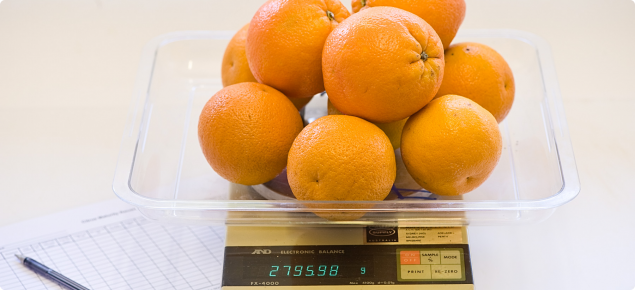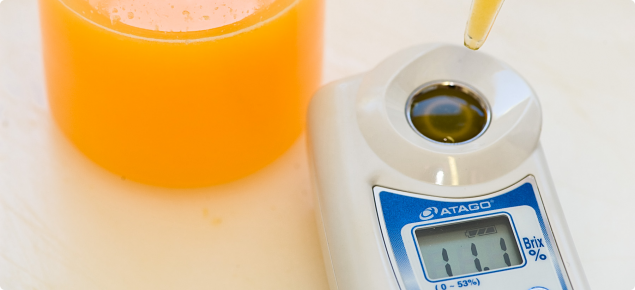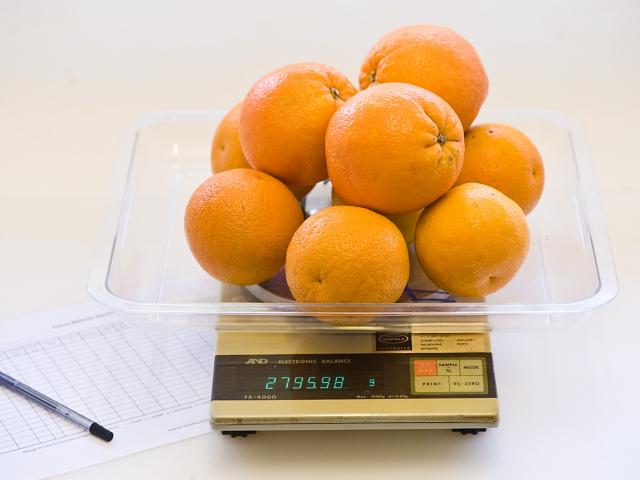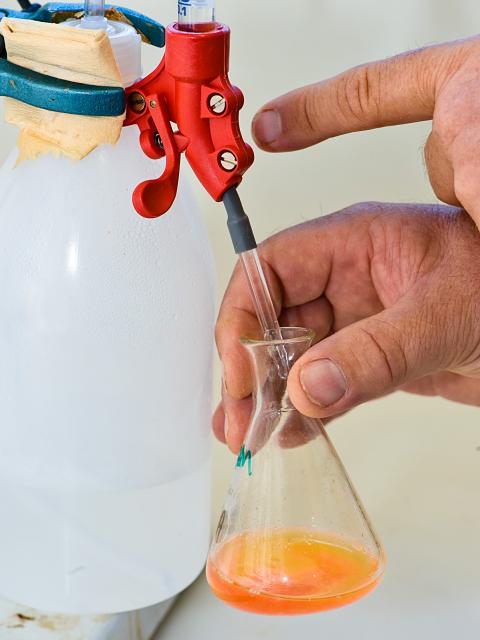Preparation
Collecting a fruit sample
When collecting fruit for testing it is important that the sample represents what you will be harvesting. For example if you plan to select pick mandarins, collect fruit of the same size and/or colour that you will be picking. If you are strip picking collect an even mix of fruit of all sizes and colours on the tree – be sure not to only pick the fruit that is most coloured.
Regardless of whether you are select or strip picking you must collect fruit from all sides of the trees as well as inside the canopy. Fruit samples should not have any rots, splits, puncture marks or other defects which may influence fruit quality.
It is important to consider variations within your orchard when collecting a sample. Separate samples should be taken from each block or patch if the variety, rootstock, tree age or soil type is different – because all these things will have an effect on fruit quality and maturity. The topography of a block can also effect maturity, especially if there is a significant slope.
Collect a minimum of 10 fruit per variety/area to be tested and ensure that samples are accurately and securely labelled. The more fruit tested the more accurate the test will be.
Equipment and chemical suppliers
Many suppliers can provide the necessary equipment and chemicals for maturity testing on citrus. These can be located in the 'Laboratory Equipment &/or Supplies' section of the Yellow Pages® or on the internet.
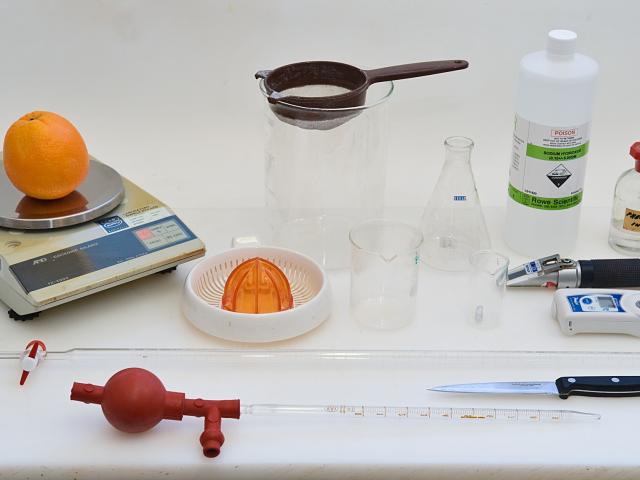
Equipment required to carry out testing
- 50mL auto-fill burette with a 1L squeeze bottle
- 10mL pipette and pump
- 0.1 Normal sodium hydroxide (NaOH) solution
- distilled water
- 1% Phenolphthalein indicator or a pH meter
- good quality scales with 1g graduations
- fruit juicer, juice only — no rind
- fine mesh strainer
- 100mL conical flask or 100mL beaker
- 1 to 2 litre jug or beaker
- refractometer (digital or hand-held prism, temperature compensating) 0-32% range.
Fruit testing procedures
Three internal maturity parameters must be measured to determine the best time to harvest fruit. These are the juice content, total soluble solids (percentage sugar or °Brix) and citric acid content. The sugar-acid ratio (°Brix ÷ %Acid) and the Australian Citrus Standard ((°Brix-(%Acid x 4)) x 16.5) can then be calculated.
Step 1: Calculating juice content - percentage juice
Juice content is an important measurement of internal quality. Under- or over-ripe fruit tends to be less juicy, which directly affects eating quality.
- Weigh your 10 fruit and record the combined weight in grams.
- Weigh the empty 1 or 2 litre jug and record the weight in grams.
- Juice all 10 fruit using the juicer. Apply even force and try to remove all the juice.
- Strain the juice into the jug. Weigh the juice and record the weight in grams, then subtract the weight of the jug.
- Calculate percentage juice content by dividing the juice weight by the total fruit weight. Multiply this by 100 to get the percentage.
Example calculation
Fruit weight = 600g
Juice weight = 300g
(Juice weight ÷ Fruit weight) x 100 = percentage (%) juice
= (300 ÷ 600) x 100 = 50% juice
Remember to subtract the weight of the jug from the weight of the juice and jug. Alternatively, place the empty jug on the scales and zero the scales prior to adding the juice.
Step 2: Calculating total soluble solids - percentage sugar or degrees Brix
Sugar levels are a common measurement in a wide range of crops. As the flesh of fruit forms it deposits nutrients as starch that transform to sugars as the fruit ripens. The percentage sugar, measured in degrees Brix (°Brix), indicates the sweetness of the fruit by measuring the soluble solids in the juice.
- Calibrate the refractometer with distilled water prior to use (distilled water should give a zero reading).
- Ensure the refractometer prism surface (glass) is clean and dry.
- Place a small amount of the fresh juice (a couple of drops is sufficient) onto the prism.
- Look through the eyepiece while pointing the prism in the direction of good light (caution: not directly at the sun).
- Focus the eyepiece and take the reading where the base of the blue colour sits on the scale — this reading is the sample’s Brix.
- Clean the refractometer immediately with a damp tissue, and dry thoroughly.
Note: If you are using a digital refractometer place two drops of fresh juice on the prism (glass) and record the reading. Clean the prism immediately after use.
Step 3: Calculating citric acid content
Citric acid gives citrus its tartness and is highest early in the season, decreasing as the fruits mature. Citric acid content can be determined using two methods:
- a chemical indicator called phenolphthalein
- a pH meter.
Both methods involve titration, which means adding a solution of known concentration to a solution of unknown concentration until a desired reaction is achieved.
Using phenolphthalein
- Draw 10mL of juice into the pipette and transfer the juice to a clean conical flask. Clean the pipette immediately after transferring the juice.
- Add two to three drops of phenolphthalein indicator to the conical flask and carefully swish mixture.
- Squeeze the burette fill bottle, containing 0.1 Normal sodium hydroxide (NaOH) solution, to fill the burette.
- Open the burette’s tap and allow a trickle of NaOH to run into an empty beaker. This is to ensure no air is trapped in the burette prior to use.
- Squeeze the burette fill bottle again until the NaOH level in the burette reads zero at the top of the scale.
- Hold the conical flask containing the juice mix under the burette and while swirling the flask slowly add the NaOH to the juice by opening the burette’s tap.
- Keep swirling the flask while adding NaOH, until the solution just starts to turn pink. As soon as the solution turns pink close the burette’s tap. Look at the scale on the burette and record how much sodium hydroxide you have added to the flask. Multiply the figure you have recorded by 0.064 to give you the percentage citric acid in your sample.
The first few times you do this procedure it may be difficult to see the colour-change point. If you look closely you will see the juice mix slowly lighten in colour, almost becoming clear and then change to light green. This is the point just before the end of the test and a few extra drops of the sodium hydroxide will make the solution turn pink.
If you go past this point and the solution changes from pink to a deep purple/orange, you have added too much sodium hydroxide and you will need to empty the conical flask and begin again.
Using a pH meter
- Draw 10mL of juice into the pipette and transfer to a clean beaker. Clean the pipette immediately after transferring the juice.
- Carefully place pH meter probe into the solution and turn on (remember to calibrate the pH meter first if required).
- Squeeze the burette fill bottle, containing 0.1 Normal sodium hydroxide (NaOH), to fill the burette.
- Open burette’s tap and allow a trickle of NaOH to run into an empty beaker. This is to ensure no air is trapped in the burette prior to use.
- Squeeze the burette fill bottle again until the NaOH level in the burette reads zero at the top of the scale.
- Hold the beaker containing the juice mixture under the burette and while swirling the beaker, slowly add the NaOH to the juice.
- Keep swirling the beaker whilst slowly adding NaOH to the solution until it reaches a pH of 8.2. Look at the scale on the burette and record how much sodium hydroxide you have added to the flask. Multiply the figure you have recorded by 0.064 — to give you the percentage citric acid in your sample.
Example calculation
Amount of NaOH added = 24.2mL
mLof NaOH x 0.064 = percentage citric acid
24.2 x 0.064 = 1.55% citric acid
Calculate the sugar-acid ratio - see Step 4.
Step 4: Calculating sugar-acid ratio
The sugar-acid ratio contributes to the unique flavour of citrus. At the beginning of the ripening process the sugar-acid ratio is low, because of low sugar content and high fruit acid content—this makes the fruit taste sour. During the ripening process the fruit acids are degraded, the sugar content increases and the sugar-acid ratio achieves a higher value.
Calculate the sugar-acid ratio by dividing the °Brix identified in Step 2 by the citric acid percentage identified in Step 3. This will give you the sugar-acid ratio of your sample.
Example calculation (sugar-acid ratio)
Sugar concentration = 15.2°Brix
Citric acid concentration = 1.55%
°Brix ÷ Citric acid percentage = sugar-acid ratio
15.2 ÷ 1.55 = 9.8 sugar-acid ratio
Step 5: Calculating Australian Citrus Standard
The Australian Citrus Standard is used as part of the national quality standards developed by Citrus Australia Ltd. It is another measure of fruit maturity and is calculated using the formula: {°Brix-(%Acid x 4)} x 16.5.
Example calculation (Australian Citrus Standard)
Sugar concentration = 15.2°Brix
Citric acid concentration = 1.55%
{°Brix - (%Acid x 4)} x 16.5 = Australian Citrus Standard
{15.2 - (1.55 x 4)} x 16.5 = Australian Citrus Standard of 148.5
Summary
The steps for carrying out maturity testing on citrus are:
- Citrus maturity standards may change from time to time so it is advisable to check with Citrus Australia or you local citrus industry body to confirm the current industry standards prior to testing.
- Collect a representative sample of at least 10 fruit for each variety to be tested. Remember that the more fruit you test and the more representative the sample, the more accurate your result will be.
- Determine the percentage juice content of the fruit (juice weight divided by fruit weight multiplied by 100).
- Determine the sugar level using a refractometer (percentage total soluble solids or
°Brix). - Determine the percentage acid by titrating 10mL of juice with 0.1 Normal sodium hydroxide solution and multiplying the result by 0.064.
- Calculate the sugar-acid ratio (°Brix divided by percentage citric acid).
- Calculate the Australian Citrus Standard {°Brix - (%Acid x 4)} x 16.5.
- Compare your test results with the standards you are using. If any standard is not attained, the fruit are not mature and should not be harvested.


